Vaginal dryness is more common than you might think, but it’s often overlooked because many women feel reluctant to talk about it. While it may seem like a minor issue, it can impact daily life. Addressing it can help bring back comfort and improve overall well-being.
Our intimate area has Skene’s and Bartholin’s glands, which create natural lubrication. These secretions are mildly acidic, helping to maintain healthy vaginal flora, reduce the risk of infections, and keep the vagina moist.
Several factors can disrupt this natural process, including hormonal imbalances, certain medications, issues with the lubricating glands, or improper hygiene practices. When vaginal dryness occurs, it may lead to symptoms like itching, burning, irritation, and discomfort during intercourse.
While it can happen at any age, vaginal dryness is more common during menopause[1] and perimenopause due to significant hormonal changes.
Friendly Reminder: The information shared here is for educational purposes only. The reader should consult a registered medical practitioner before implementing any changes to their health routine.
Most of the time, vaginal dryness results from decreased levels of the female hormone called estrogen[8]. Vaginal dryness can also develop in people undergoing treatment for some other condition. Some common causes of vaginal dryness are:
Other symptoms can accompany vaginal dryness:
Here are some popular home remedies that may help with vaginal dryness. Please note that these remedies may not work for everyone. Before using any herbal remedies, it is advisable to consult with your doctor and follow their advice.
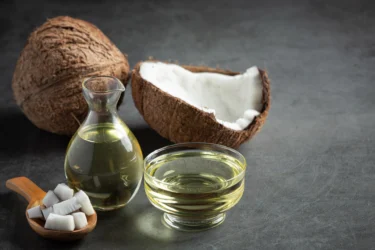
You can use natural oils like coconut oil to help relieve vaginal dryness. Cold-pressed virgin coconut oil is the purest form. It has many health benefits, and it may be used to relieve dry skin. Coconut oil is a natural emollient (skin soothing) and might help moisturise the skin.
You can apply coconut oil evenly on the outer surface of the vagina (pubis, labia majora) by massaging slowly. Make sure to clean your hands first before you touch your intimate parts. Caution to take here is not to use oil on mucosa(inner surface of the intimate area) or to apply oil inside of the vagina as it may increase the risk of a fungal infection[5].
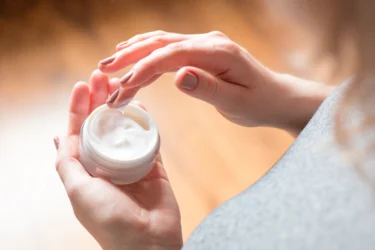
You can try non-fragrant moisturisers for dry, sensitive skin to help with vaginal dryness. Using moisturisers[6] can help you lock in moisture in the skin around the vagina and aid in dealing with vaginal dryness. Applying a small quantity of moisturiser on the outer surface of the vagina helps to relieve itching due to dryness of the skin[3].
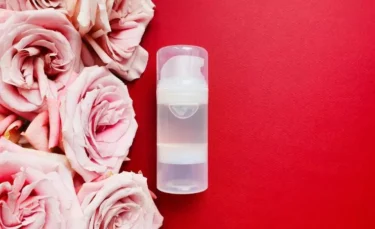
You may use any water-based lubricant before intercourse to get rid of problems due to vaginal dryness. These lubricants might provide short-term moisturisation. Lubricants can be applied in and around the vagina or on your partner’s penis to avoid any discomfort during sex and help get rid of discomfort due to vaginal dryness. Make sure you or your partner is not allergic to any lubricant content. Do a patch test before using a new product on your intimate area[3].

Vaginal lubrication during intercourse depends on arousal[9]. Before indulging in sexual intercourse, try more extended foreplay. Enjoying more foreplay could help you get more aroused during sex which leads the secretory glands to secret natural lubrication and helps in preventing problems due to vaginal dryness. Bartholin’s gland, present at the entrance of the vagina, produces moisture during sexual arousal.
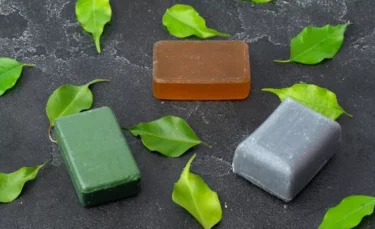
Avoid using heavily perfumed soap, cleanser or lotion in and around your vagina. These chemicals can cause irritation and dryness in the vagina. Using perfumed soaps or cleansers or practising vaginal douching[10] is one of the factors responsible for causing vaginal dryness. Even using intimate area cleaning solutions frequently or washing the area with soap every time after using the washroom can lead to dryness and irritation. Patting it dry is sufficient in case of any foul-smelling secretion. For any coloured discharge from the vagina, better to consult a dermatologist rather than wait for the infection to flourish.
Though there are studies that show the benefits of the given home remedies in dealing with vaginal dryness, these are insufficient. There is a need for large-scale human studies to establish the true extent of the benefits of these home remedies on human health. Thus, these should only be taken cautiously and never as a substitute for medical treatment.
Also Read: Things You Shouldn’t Do Before And After Sex
Some women might feel embarrassed to talk to their doctors about vaginal dryness. Still, vaginal dryness is a pretty common condition, and many treatment options are available. You can contact your healthcare provider if:
Also Read: Simple Home Remedies for Frequent Urination
Vaginal dryness is a common concern that can affect any woman, but it’s more common in menopausal women in their 50s. If it’s impacting your daily activities, please seek medical help.
While hormonal changes and ageing are common culprits, factors like diabetes, thyroid disorders, and even stress can also contribute to vaginal dryness.
Don’t let embarrassment hold you back from seeking the help you deserve. Take charge of your well-being and enjoy a more comfortable, happier life.
Also Read: HPV Vaccine: What is It, When to Be Taken, Importance & Side Effects
You can use cold-pressed virgin coconut oil for vaginal dryness. Do not apply oil inside the vagina; use this only on the external skin. Consult your healthcare provider before using any home remedies for dryness in private parts. Also, discontinue its use and contact your healthcare provider if you feel any itchiness or irritation.
You can use water-based lubricants[6]. These can be used inside and around the vagina to provide short-term lubrication. Before engaging in sexual intercourse, you can try more foreplay. Feeling more aroused during intercourse might help lubricate the vagina.
If you are experiencing vaginal dryness, you might develop complications like bacterial or yeast infections in the vagina, pain during sexual intercourse[4], urinary tract infections, and sores in the vaginal wall.
If your dry vagina is causing you any discomfort or irritation in your daily activities, you should reach out to your doctor. Also, if the dry vagina is causing pain and discomfort during sexual intercourse, communicate with your partner and get medical help.
1. Women’s Health Concern. Vaginal dryness – Women’s Health Concern [Internet]. [Cited 2022 Jun 7]. Available from: https://www.womens-health-concern.org/help-and-advice/factsheets/vaginal-dryness/
2. NHS. Vaginal dryness [Internet]. [Cited 2022 Jun 6]. Available from: https://www.nhs.uk/conditions/vaginal-dryness/
3. The American College of Obstetricians and Gynecologists. Experiencing Vaginal Dryness? Here’s What You Need to Know. [Internet]. [Cited 2022 Jun 7]. Available from: https://www.acog.org/womens-health/experts-and-stories/the-latest/experiencing-vaginal-dryness-heres-what-you-need-to-know
4. MedlinePlus Medical Encyclopedia. Vaginal dryness [Internet]. [Cited 2022 Jun 7]. Available from: https://medlineplus.gov/ency/article/000892.htm
5. Albornoz MA, Burke JF, Threlfall EK. Virgin Coconut Oil in Paste Form as Treatment for Dyspareunia and Vaginal Dryness in Patients With and Without Rheumatic Autoimmune Diseases: An Efficacy and Safety Assessment Pilot Study. Cureus. 2023 Jun 16;15(6):e40501. [cited 2025 Feb 25]. https://pmc.ncbi.nlm.nih.gov/articles/PMC10350307/
6. Potter N, Panay N. Vaginal lubricants and moisturizers: a review into use, efficacy, and safety. Climacteric. 2021 Feb;24(1):19-24. doi: 10.1080/13697137.2020.1820478. PMID: 32990054. https://pubmed.ncbi.nlm.nih.gov/32990054/
7. ScienceDirect. Vaginal Dryness: Definition. In: ScienceDirect Topics [Internet]. Amsterdam: Elsevier; [cited 2025 Feb 25]. https://www.sciencedirect.com/topics/medicine-and-dentistry/vaginal-dryness#definition
8. Factors associated with developing vaginal dryness symptoms in women transitioning through menopause: a longitudinal study. Available from: https://pmc.ncbi.nlm.nih.gov/articles/PMC6136974/
9. Physiologic Measures of Sexual Function in Women: A Review. Available from: https://pmc.ncbi.nlm.nih.gov/articles/PMC2771367/
10. Vaginal Douching: Evidence for Risks or Benefits to Women’s Health. Available from: https://pmc.ncbi.nlm.nih.gov/articles/PMC2567125/
Disclaimer: The information provided here is for educational/awareness purposes only and is not intended to be a substitute for medical treatment by a healthcare professional and should not be relied upon to diagnose or treat any medical condition. The reader should consult a registered medical practitioner to determine the appropriateness of the information and before consuming any medication. PharmEasy does not provide any guarantee or warranty (express or implied) regarding the accuracy, adequacy, completeness, legality, reliability or usefulness of the information; and disclaims any liability arising thereof.
Is your breast pain the cause of your worry? It might just be because of your upcoming menstrual period. Breast pain is also called mastalgia or mastodynia, and it can occur due to a variety of reasons, the most common being the menstrual period. Unlike popular belief, breast pain does not always mean breast cancer1. However, if you feel a few lumps in your breast that won’t go away along with soreness of breasts, you should visit a doctor and get things clarified. Mostly, breast pain is manageable and can go away with a few lifestyle modifications.
The common causes of breast pain are listed below:
Breast pain itself is a symptom which can occur due to the above-stated causes. However, the pain can be of different kinds and can differ depending on whether you have cyclic (coincides with menstrual cycles) or non-cyclic (doesn’t coincide with the menstrual cycle) breast pain1. If it’s cyclic breast pain, you’ll feel:
If you have non-cyclic breast pain, then you might experience the following symptoms:
Symptoms of non-cyclic breast pain may stay for a long time or may come and go over time.
Also Read: Simple Home Remedies for Prolonged Periods
Your breast pain might go away with your periods. But, if you feel a lot of discomfort and are looking for natural remedies for breast pain, we have a few for you. You can try a few or all of these home remedies for breast pain and choose whichever suits you best. However, it’s better to also consult a doctor and get things clarified.
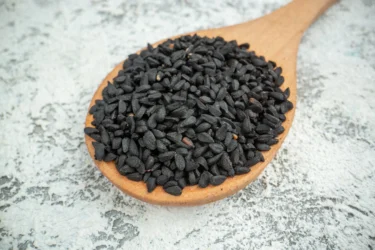
The seeds of kalonji, also known as Nigella sativa or fennel flower, contain many bioactive compounds, and essential oil is obtained from them. The essential oil of kalonji was used for a study to determine the effectiveness of kalonji in managing breast pain. When mixed in water and honey, this study3 showed that the syrup of kalonji oil and paraffin might help with breast pain. You can use kalonji as a natural remedy for breast pain by taking a few kalonji seeds, making a powder out of it, mixing the powder in water and honey and drinking it.

Scientifically known as Oenothera biennis, the evening primrose is medically valuable due to the high presence of fatty acids in it. It may alleviate inflammation by inhibiting certain compounds responsible for inflammation. The most important activity of evening primrose is that it is good for managing breast pain3. In a study3, it was found to have similar effects as Vitamin E on breast pain. You can use the essential oil obtained from evening primrose as a quick remedy for breast pain by adding a few drops in tea and drinking it. You can also add it to hot water and drink it. Sometimes, it can be mixed in a carrier oil and used for massaging the breasts.
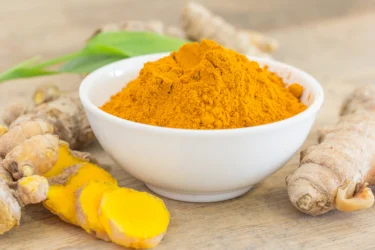
Turmeric might have antioxidant properties similar to vitamins E and C. A study3 showed that curcumin given to women before their menstrual period helped reduce the breast pain that they experienced. You can mix a little turmeric powder in warm milk and drink it before your periods begin to decrease breast pain. It may prove to be a useful hack for cyclic breast pain.
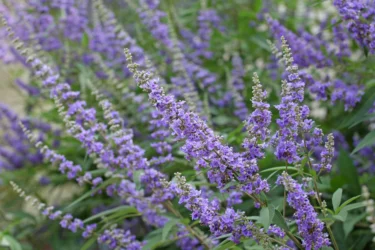
The chaste tree, also known as Vitex agnus-castus, is a plant with long-fingered leaves. Traditionally, it was used to deal with women’s fertility disorders, including PMS and breast pain (cyclic mastalgia). A study5 on humans shows that the chaste tree might be helpful in managing breast pain. You can use a few drops of chaste tree oil by mixing in warm water or tea with a little bit of honey. This remedy might help reduce your breast pain.
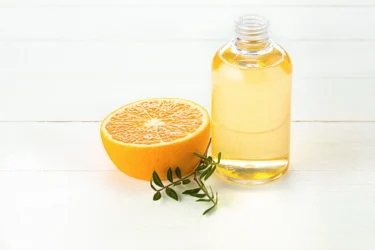
The oil of orange skin (Citrus sinensis) contains many components that might benefit the central nervous system, such as pain reduction, muscle relaxation, and mood elevation. A study3 showed that consuming orange skin essential oil over time could reduce the effects of PMS on the body. Therefore, it may be used as a remedy to get relief from breast pain. Add a few drops of orange skin essential oil to a cup of warm water and drink it. To reap its beneficial effects for breast pain, you might have to follow the remedy diligently. However, it is better to consult a doctor if the pain persists or the condition worsens. he pain persists or the condition worsens.
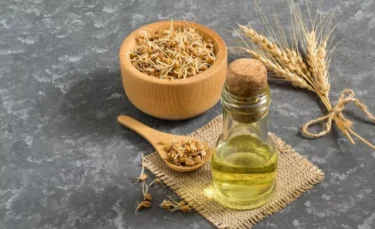
Wheat germ contains multiple nutrients, minerals and vitamins, making it helpful for managing various diseases. . So, a study6 was conducted to see if it is effective in alleviating breast pain. In this study, it was seen that wheat germ consumption significantly reduced breast pain in women. You can include wheat in your diet to obtain the benefits of wheat germ. You can also try wheat germ oil by mixing a few drops in a glass of water and honey and drinking it.

The extract of the plant Ginkgo biloba was found to be useful in the management of breast pain. The effectiveness of this plant extract was seen in a study3 when the extract was consumed over a while. You can use dried Gingko that is often available in the market and boil it in water to obtain a decoction.
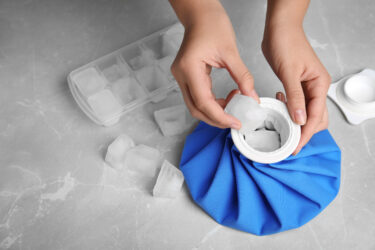
A quick remedy for breast pain would be to apply heat or cold to it. To the most painful area on your breast, you can apply heat, but make sure to protect your skin. You can use a hot or cold pack for application on the breast, but if it is too hot or too cold, it can damage your skin, so make sure that you use an optimum temperature for heat or cold compress. Though there are studies that show the benefits of the given herbs and home remedies for breast pain, these are insufficient, and there is a need for further studies to establish the true extent of the benefits of these herbs and home remedies on human health. Thus, these should only be taken under the guidance and supervision of your doctor.
A clinical breast examination supplemented with an ultrasound or a mammogram are good starting points to diagnose causes of persistent breast pain.
Dr Ashish Bajaj, M.B.B.S M.D. in Clinical Pharmacology and Toxicology
You should visit a doctor and seek their advice if you notice the following:
You must not completely rely on home remedies for the management of breast pain. You should consult a qualified doctor for any advice related to breast pain and related symptoms.
The most common type of breast pain is linked to the menstrual cycle. It is nearly always hormonal. Some women begin to have pain around the time of ovulation. The pain continues until the start of their menstrual cycle which doesn’t require any treatment
Dr. M.G. Kartheeka, MBBS MD(Pediatrics)
Breast pain, also called mastalgia, can occur due to many reasons such as hormone changes (puberty, pregnancy and menopause), certain medications, increased caffeine intake, smoking, etc. It is very common and can occur along with menstrual period (cyclic) or not (non-cyclic), and it varies in severity with each person. Although it goes away on its own, you can try a few natural remedies for breast pain like turmeric, orange skin oil, wheat germ or cold compress. You can try a few of them and see what sticks with you. However, if the pain persists for more than a few days, or you notice a discharge from the nipples or have signs of infection (redness, swelling and fever), you should visit a doctor.
Also Read: Can You Increase Your Breast Size Naturally? Here’s What Doctors Want You To Know
Yes, turmeric has curcumin which was found to be effective in relieving breast soreness in studies7. You can use a little bit of turmeric powder by mixing it in warm milk and drinking it daily. But it is advisable to consult a doctor for proper advice.
You can use an ice pack or hot compress to apply to the sore area of your breast as a quick home remedy for breast pain. Ensure that the object you use for the hot compress is not too hot as it can damage your skin.
There are several home remedies for breast pain which you can use, like turmeric, evening primrose, chaste tree, orange skin oil, kalonji, etc. You can try a few or all of them to relieve breast pain. However, if the problem persists, you should consult your doctor.
No. Breast pain does not always indicate breast cancer. You can have breast pain due to your menstrual period, pregnancy, menopause, certain medicines, smoking, increased caffeine intake, etc. However, if you feel lumps in your breast that don’t go away, you should visit a doctor.
No. There is inadequate research supporting the use of methi for the management of breast pain. There is a need for more scientific studies to back the use of methi for breast pain.
Disclaimer: The information provided here is for educational/awareness purposes only and is not intended to be a substitute for medical treatment by a healthcare professional and should not be relied upon to diagnose or treat any medical condition. The reader should consult a registered medical practitioner to determine the appropriateness of the information and before consuming any medication. PharmEasy does not provide any guarantee or warranty (express or implied) regarding the accuracy, adequacy, completeness, legality, reliability or usefulness of the information; and disclaims any liability arising thereof.
Reducing belly fat is a common goal for many, not just for appearance but also to lower health risks like diabetes, obesity, and heart disease[¹]. Belly fat, also known as visceral fat, accumulates in the abdominal area and is also common among men[¹]. While regular exercise and a balanced diet are essential for reducing belly fat, there are also simple home remedies that can support your journey toward a healthier and more active life.
Friendly Reminder: The information shared here is for educational purposes only and the reader should consult a registered medical practitioner before implementing any changes to their health routine.
Reasons that can cause fat accumulation in your body are:
Some other factors can also lead to fat accumulation in the body:
Today, more and more people are becoming aware and want to have a healthy body. Here are some home remedies that might help to lose belly fat.

Doing a moderate amount of physical exercise may help combat belly fat. You can start by doing 30 minutes of moderate to high-intensity exercise each day to help manage belly fat and reduce weight. You can slowly increase your exercise duration. Exercising with weights (strength training) is an effective way to manage belly fat. Other effective options are sit-ups and crunches[¹].
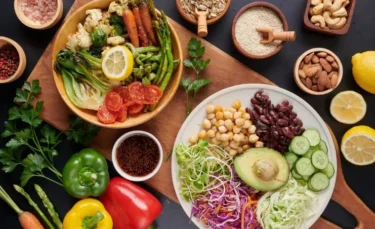
Diet plays an important role in fat deposition in the body. Pay close attention to the quality and quantity of food that you eat. Make vegetables, fruit, and wholegrain a part of your everyday diet. Avoid simple carbohydrates like white bread, sugary drinks, and refined grains[¹]. Here are some good eating habits that you can follow for healthy living:
Making suitable diet changes and changing eating habits is an effective way to reduce belly fat.
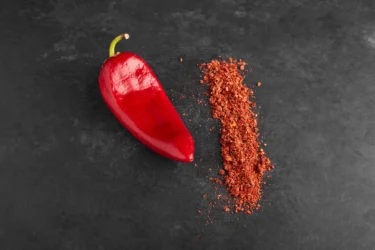
Intake of capsicum or chilli pepper may help reduce accumulated fat in the body. Also, capsicum might be valuable to promote the use of fat collected in the body[5]. You can add capsicum to your foods but remember to use it in moderation.
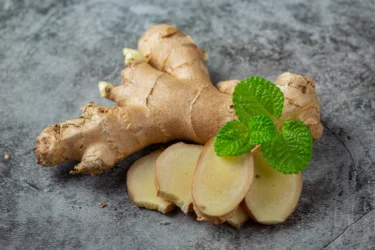
Ginger may offer many health benefits for people wanting to reduce belly fat. Taking ginger is associated with enhanced fat metabolism in the body. Ginger could also facilitate the usage of fat in the body. Taking ginger also helps reduce fat storage in the body, causing an overall reduction in body weight[5].
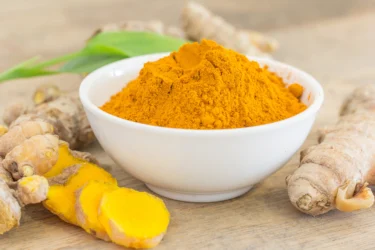
Turmeric has many health advantages. Turmeric may reduce the fat deposit in the body. It could help reduce body fat and body weight as per studies[5]. You can mix some turmeric in a glass of warm water and consume it every morning may help reduce belly fat.
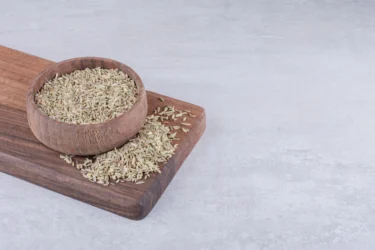
Cumin or jeera is a common seed used as a spice in many Indian households. Cumin has many health benefits and is often used for dealing with diarrhoea and other stomach diseases. In addition, intake of cumin may help enhance fat breakdown in the body and reduce appetite[6]. These benefits of cumin might help you reduce belly fat and attain a healthy weight yourself.
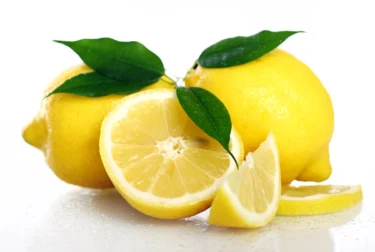
Lemons are known to promote fat metabolism and manage body weight and fat accumulation[7]. Lemon might help reduce the accumulation of belly fat in some cases. Add some lemon juice to a glass of warm water and drink it first thing in the morning. Do not consume lemon or lemon juice if it does not suit you.
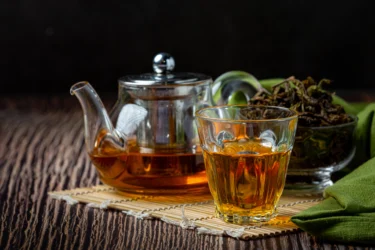
Green tea is a popular beverage used to maintain health and helps prevent numerous diseases and it could also reduce fat accumulation in the body. Use your choice of freshly brewed green tea (avoid plastic tea bags) to replace sugary beverages like tea or other packaged drinks. Other benefits like reduction in body weight and fatty tissues have also been observed[8]. Brew a cup of green tea and drink it every morning to help reduce belly fat and manage weight.

Stay aware of your eating habits and physical activity with positive intent. Mindful eating may help with gaining satisfaction and reduce the chances of overeating. Make healthy choices and manage portions.

Yoga asanas can help reduce weight and do wonders in managing stress. Stress is a known risk factor for weight gain and can contribute to belly weight. Learn yoga under the guidance of a certified yoga trainer for best results[9].
While some studies suggest that certain herbs and home remedies like those mentioned above may help reduce belly fat, the evidence is not comprehensive enough. More research is needed to understand the actual benefits of these remedies. Hence, they should be approached with caution and should never replace substitute medical treatment.
Also Read: Mounjaro (Injection): Uses, Side Effects, Dosage, and How It Works
You can contact your doctor and seek medical help:
You must not rely on home remedies alone for the management of belly fat. It is also advisable to consult a qualified doctor for advice if your condition doesn’t improve.
Belly fat, or abdominal obesity, is not just a matter of appearance; it’s a well-established risk factor for serious health conditions such as heart disease and type 2 diabetes. With growing awareness of these health risks, more people are making healthy lifestyle choices to reduce belly fat. However, it’s important to remember that underlying factors such as chronic conditions, hormonal imbalances, and ongoing medications can also contribute to belly fat. Addressing these root causes is important for long-term success. Always consult your doctor for guidance on managing abdominal obesity effectively.
Also Read: Acidity Problems? 21 Home Remedies That Can Help
Herbs like turmeric, ginger, green tea, chilli pepper, cumin and lemon might help you burn the fat accumulated in the belly. There is no evidence to prove these benefits. Doing regular physical exercise and maintaining a healthy diet are other proven ways to help you reduce belly fat[¹].
Yes, some studies have found green tea to be an effective option for reducing belly fat. This is because green tea contains active compounds that help reduce fat accumulation in the body[8]. It is important to understand that reducing fat depends on overall diet (calorie intake) and physical activity (calorie expenditure) along with other factors.
You need to avoid sugary drinks, simple carbohydrates like white bread and foods made of refined grains[¹]. Cut down on oily, fried and processed foods.
Excessive buildup of fat in the belly can lead to obesity, diabetes, heart diseases, kidney diseases, high blood pressure, fatty liver disease, and cancer. It can also lead to problems in pregnancy in women[4].
1. Harvard Health. Abdominal fat and what to do about it [Internet]. [cited 2022 Jun 8]. Available from: https://www.health.harvard.edu/staying-healthy/abdominal-fat-and-what-to-do-about-it
2. Penn Medicine. Obesity – Symptoms and Causes [Internet]. [cited 2022 Jun 8]. Available from: https://www.pennmedicine.org/for-patients-and-visitors/patient-information/conditions-treated-a-to-z/obesity
3. Healthdirect. Obesity – signs, symptoms, causes and complications [Internet]. [cited 2022 Jun 8]. Available from: https://www.healthdirect.gov.au/obesity
4. NIDDK. Health Risks of Overweight & Obesity [Internet]. [cited 2022 Jun 8]. Available from: https://www.niddk.nih.gov/health-information/weight-management/adult-overweight-obesity/health-risks
5. Jiang TA. Health Benefits of Culinary Herbs and Spices. Journal of AOAC INTERNATIONAL [Internet]. 2019 Mar 1 [cited 2022 Jun 8];102(2):395–411. Available from: https://academic.oup.com/jaoac/article/102/2/395/5658185
6. Taghizadeh M, Memarzadeh MR, Abedi F, Sharifi N, Karamali F, Kashan ZF, et al. The Effect of Cumin cyminum L. Plus Lime Administration on Weight Loss and Metabolic Status in Overweight Subjects: A Randomized Double-Blind Placebo-Controlled Clinical Trial. Iranian Red Crescent Medical Journal [Internet]. 2016 Aug 1 [cited 2022 Jun 8];18(8):34212. Available from: https://pubmed.ncbi.nlm.nih.gov/27781121/
7. Fukuchi Y, Hiramitsu M, Okada M, Hayashi S, Nabeno Y, Osawa T, et al. Lemon Polyphenols Suppress Diet-induced Obesity by Up-Regulation of mRNA Levels of the Enzymes Involved in β-Oxidation in Mouse White Adipose Tissue. Journal of Clinical Biochemistry and Nutrition [Internet]. 2008 [cited 2022 Jun 8];43(3):201. Available from: https://pubmed.ncbi.nlm.nih.gov/19015756/
8. Sae-Tan S, Grove KA, Lambert JD. Weight control and prevention of metabolic syndrome by green tea. Pharmacological Research. 2011 Aug 1;64(2):146–54. Available from: https://www.sciencedirect.com/science/article/abs/pii/S1043661810002380 9. Cramer H, Thoms MS, Anheyer D, Lauche R, Dobos G. Yoga in women with abdominal obesity—a randomized controlled trial. Dtsch Arztebl Int. 2016 Sep 30;113(39):645-652. PMID: 27776622. [cited 2025 Feb 25]. https://pmc.ncbi.nlm.nih.gov/articles/PMC5098025/
Disclaimer: The information provided here is for educational/awareness purposes only and is not intended to be a substitute for medical treatment by a healthcare professional and should not be relied upon to diagnose or treat any medical condition. The reader should consult a registered medical practitioner to determine the appropriateness of the information and before consuming any medication. PharmEasy does not provide any guarantee or warranty (express or implied) regarding the accuracy, adequacy, completeness, legality, reliability or usefulness of the information; and disclaims any liability arising thereof.
Clove is an unopened flower bud growing on the tree Syzgium aromaticum, belonging to the family Myrtaceae. Cloves have a deep brown colour and a powerful fragrant odour that is warm, strongly sweet, pungent, and slightly astringent1.
Clove is known by several names like Laung, Lavang, Laumg in Hindi; Lavanga, Lavangaka, Lavangam, Bhadrasriya, Devakusuma, Haricandana, Devapuspa, Varala in Sanskrit; Luvang in Marathi; Lavang in Gujarati; Lavanga in Bengali; Laung in Punjabi; Labanga in Oriya; Laung, Loung in Urdu; Grampu, Karayampu, Karampu in Malayalam; Lavanga, Krambu; Daevakusuma in Kannada; Kaaravallu, Devakusumamu, Lavangalu, Lavangamu in Telugu; Kirampu, Kiraambu, Kirambu, Grambu, Ilavankam in Tamil1.
Clove is considered the symbol of dignity and is a valuable and precious spice of the world. It is commonly used in garam masala, salads, pickles, and biryanis1. Clove is mainly produced in countries like Indonesia, Malaysia, India, Sri Lanka, Tanzania, and Madagascar. Clove may have several medicinal properties like antioxidant, pain-killing, anti-bacterial and anti-viral2.
Did You Know?
Clove contains the following nutrients (per 100g)1:
Some studies11 suggest that the intake of clove along with ginger may have anti-diabetic properties. Its consumption might help in reducing blood sugar levels in type 2 diabetes.
Dr. Siddharth Gupta, B.A.M.S, M.D (Ayu)
Clove may show the following properties:
The potential uses of clove are given as follows.
Clove was tested for antimicrobial activities against several fungi and bacterial strains. During lab trials, clove showed bacteria-killing activity against all foodborne pathogens, including E. coli, Bacillus cereus, and Staphylococcus aureus7. Clove oil was found to be efficient against Staphylococcus species. Aspergillus niger (fungi) was highly sensitive to clove oil. Also, clove oil showed germicidal effects against Klebsiella Pneumoniae, Pseudomonas aeruginosa, Clostridium perfringens, S. aureus, E. coli, and Candida albicans during a lab study6. It was also found to kill Bacillus tuberculosis efficiently.1 The antimicrobial properties have been observed in lab studies. More trials are required to support clove against infectious diseases in humans. Therefore, do not use clove oil before consulting your healthcare provider.
The clove extract was tested for liver protective activity in an animal model8. The clove extract restored the activity of aspartate aminotransferase, alanine transaminase, and alkaline phosphatase enzymes in serum and therefore showed liver protective activity. However, if you are experiencing any liver problems, consult your healthcare provider before using clove as a remedy.
Clove oil (eugenol) may help clear the respiratory passages and act as an expectorant for managing several upper-respiratory diseases like bronchitis, cough, cold, asthma, and sinus conditions. Clove contains various flavonoids like β-caryophyllene, kaempferol, and rhamnetin that might contribute to its antioxidant and anti-inflammatory activity3. You must talk to your healthcare provider before using clove or its oil for any inflammatory conditions.
Clove and eugenol have shown strong antioxidant properties in trials. Clove has a high capacity to reduce lipid peroxidation and give off hydrogen1. In the database of the United States Department of Agriculture, along with universities and private companies, it is indicated that clove has a higher content of polyphenols and other antioxidant compounds. Clove bud extract may be used as a food antioxidant2. In some studies9, it was observed that kidney functions, liver functions, and antioxidant status were improved with clove use. Before using clove or any herb for its health benefits, you need to contact your healthcare provider and get a proper diagnosis.
The pain-killing effect of clove has been documented since the 13th century. Clove oil might be effective in dealing with joint pain, tooth pain, and spasmodic pain2. Clove oil has been widely used as an analgesic (pain killer) agent in dental clinics as it can relieve toothache. It may suppress inflammatory mediators (leukotriene) and prostaglandin. Also, it is thought to suppress the sensory receptors responsible for signalling pain. You should use clove under the supervision of a healthcare provider or after a doctor’s consultation only.
Clove oil helps deal with bloating and gas. In addition, clove oil may be an effective remedy for stomach-related conditions like motion sickness, nausea, hiccups, and vomiting2,4. If you are suffering from any stomach problems, you should talk to your doctor to come up with a diagnosis. Using herbs or remedies without talking to your doctor can worsen the situation.
Clove oil is believed to stimulate the circulatory system, which might help manage insomnia, anxiety, memory loss, depression, fatigue, and mental exhaustion4. Clove oil was tested for managing depression in an animal model10. It was found to be helpful as it showed an anti-depressant effect. However, do not use clove oil as an alternative to medicinal treatment. If you are suffering from psychological distress, always talk to your doctor or psychiatrist.
Because of the potential antioxidant activity of clove, it is thought to have an anti-cancer effect. It was found to have anti-cancer activity against the skin, lungs, and digestive cancers. The anti-tumour action may be due to the presence of oleanic acid. Also, it has been reported to show anti-cancer activity against colorectal, breast, and leukaemia cancer cells4. Large human-scale studies are required to support the use of clove against cancer in humans. Therefore, you are advised to adhere to the doctor’s treatment and advice for cancer.
Though there are studies showing the benefits of clove in various conditions, these are insufficient and there is a need for further studies to establish the true extent of the benefits of clove on human health.
According to some research12, clove extracts and clove oil might possess inhibitory properties against certain enzymes like acetylcholinesterase, which are responsible for the destruction of certain neurotransmitters like acetylcholine. Such effects of clove extract and clove oil to act as an anti-cholinesterase agent might be beneficial against diseases like Alzheimer’s disease.
Dr. Rajeev Singh, BAMS
Clove can be used as:
These are used in several dental products like toothpaste, dental creams, throat sprays, and mouthwashes1.
You must consult a qualified doctor before taking cloves or any herbal supplements. Likewise, do not discontinue or replace an ongoing modern medical treatment with an ayurvedic/herbal preparation without consulting a qualified doctor.
The side effects associated with clove use are given below.
Before using clove or any herb for its health benefits, talk to your healthcare provider about the possible side effects associated with its use. It will help you avoid unwanted side effects.
Also Read: Black Salt: Uses, Benefits, Side Effects, Precautions & More!
Here are some general precautions you need to take while using cloves.
Also, before you use clove for any of its benefits on health, talk to your healthcare provider about the possible precautions and limitations of using clove. It will help you make well-informed choices.
Clove may increase the risk of bleeding or enhance the effects of warfarin therapy.
If you are taking medicines for any disease, talk to your doctor about the possible interactions of medication with other herbs and drugs. It will help you avoid unwanted herb-drug interactions.
Also Read: 15 Amazing Health Benefits of Turmeric Milk!
Clove is an unopened flower bud growing on the Syzgium aromaticum tree.
Yes, clove oil is widely used as a painkiller in dental clinics as it can relieve toothache. However, if you are experiencing tooth pain or dental problems, do reach out to your dentist for a check-up. Using herbal remedies without consulting your dentist first can worsen the condition.
Clove can be used in the form of whole spice, powder or oil. You are advised to talk to a doctor before using cloves for their health effects. He will advise the exact dosage and form of the herb to be taken, as per your condition.
Clove may be suitable for health as it has antioxidant and anti-inflammatory properties. It may manage stomach-related diseases (loose motions, flatulence, nausea, indigestion, vomiting, gastric irritability, diarrhoea), respiratory conditions (cold, cough, bronchitis, sinusitis, asthma) and many more. But it must be consumed in the right amount. An overdose can cause side effects too. Side effects include rare allergic reactions, local irritation, contact dermatitis, haemorrhagic pulmonary oedema, bronchitis, pneumonia, occupational allergic contact dermatitis, and central nervous system depression. Therefore, use clove after consulting with a qualified physician only.
Yes, clove might be good for the lungs. Its oil, when inhaled, may soothe cold, cough, bronchitis, sinusitis, and asthma. It may also clear the nasal passage. But lung problems can be severe, and you are advised to contact your healthcare provider and receive a proper diagnosis and treatment.
Yes, clove may help relieve bloating. Clove oil is known to aid digestion and reduce gas pressure in the stomach. However, it should be used only after consulting a healthcare professional.
It is safe for children, but in the right dose/amount. Clove oil in higher doses is a cytotoxin and causes severe acute kidney or liver injury in children. Therefore, please take precautions before giving cloves to children. Do not use cloves for any health issues in children unless recommended by the doctor.
Disclaimer: The information provided here is for educational/awareness purposes only and is not intended to be a substitute for medical treatment by a healthcare professional and should not be relied upon to diagnose or treat any medical condition. The reader should consult a registered medical practitioner to determine the appropriateness of the information and before consuming any medication. PharmEasy does not provide any guarantee or warranty (express or implied) regarding the accuracy, adequacy, completeness, legality, reliability or usefulness of the information; and disclaims any liability arising thereof.
Sexual health and intimacy are important aspects of life, but they come with responsibilities and care. While most people focus on enhancing the experience, they often overlook the importance of what happens before and after.
From avoiding certain habits to understanding essential hygiene practices, knowing what not to do is just as important as knowing what to do. This blog covers some critical ‘don’ts’ before and after sex to help you stay healthy, comfortable, and confident.
Friendly Reminder: The information shared here is for educational purposes only and the reader should consult a registered medical practitioner before implementing any changes to their health routine.
If you intend to have sex, reduce the amount of spice you consume. Spicy foods, such as curry and peppers, can cause acid reflux symptoms[10] such as heartburn and a burning sensation in the throat, making it difficult to relax. Rich, heavy foods high in fat, like fried chicken, carbonated drinks and caffeinated beverages, can all cause heartburn because they are more difficult for your body to digest. So, take it easy on your stomach. Bananas, oatmeal, apples and graham crackers are less likely to cause heartburn.
Alcohol is a known risk factor for Erectile Dysfunction (ED)[2], a condition that makes it difficult to obtain or maintain a strong enough erection. Though a few alcohol-related incidents do not necessarily indicate that you have ED, frequent heavy boozing can lead to long-term problems. Remember there is no safe level of drinking alcohol[1], and it should be avoided in the best interest of your health.
Shaving makes the skin around your genitals more fragile, sensitive and prone to irritation from sex friction. Reduce your risk by shaving the day before you’re going to be intimate. Hair removal is a personal choice. It’s absolutely alright if you do not prefer to shave or wax your intimate areas[5].
It is important to maintain your hygiene. Shower every day and brush your teeth properly. Wear fresh and clean clothes. This reduces the risk of body odour and bad breath, which may ruin your mood.
Depending on your mutual understanding, use a suitable mode of precaution to reduce the risk of sexually transmitted infections and unwanted pregnancies.
Also Read: Home Remedies For Vaginal Yeast Infection
You are likely to feel relaxed and sleepy due to the hormones released after sex. Even if you’re tired, there are a few things you should not do right after sex to keep your body as healthy as possible.
So let’s take a look at what not to do after sex:
Using the bathroom before and after sex can help reduce the risk of urinary tract infections (UTIs)[11]. Emptying your bladder flushes out any bacteria that may have entered the urethra during intimacy. While it’s not mandatory to go immediately, making it a habit can support better hygiene and urinary health. So, listen to your body and prioritise a quick bathroom break when needed.
An after-sex shower is good; however, jumping into a warm bathtub right after sex is not good. As a response to sexual stimulation, the vagina opens a little more. But when you take a warm bath or shower just after that, you become more vulnerable to infections.
Dr. M.G. Kartheeka, MBBS, MD(Pediatrics)
While scented soaps, gels, washes, lotions and other genital health products are good, they can irritate internal and external skin and should be avoided after sex. Soaps and products with a lot of added fragrances can alter the good and normal bacteria. Washing the genitals with simply normal to lukewarm water is recommended. To avoid irritating the genital area with harsh scents or chemicals, keep your post-sex cleansing routine as simple and gentle as possible.
Although douching[1] after sex is frequently marketed as a safe and healthy way to prevent pregnancy or sexually transmitted infections, experts advise against it because it alters your normal vaginal flora and increases your risk of UTIs, yeast infections and bacterial vaginosis, a condition caused by vaginal inflammation caused by bacterial overgrowth[3].
Because excess bodily fluids and friction can spread bacteria, it’s best to allow for proper airflow and drainage. That’s why tight-fitting nightwear should be avoided.
Being present with your partner at the moment increases your intimate connection and is a great way to bond with one another. Regular STI testing is also an important part of sexual health, but you shouldn’t wait until after you’ve had sex to communicate openly and honestly with your partner about any concerns you may have.
Also Read: Human Papillomavirus (HPV): What Is It, Causes, Symptoms, and Prevention
It’s advisable to avoid heavy meals before sex as digestion may divert blood flow from intimate areas, affecting performance and comfort.
Excessive alcohol can impair judgment and physical function. It’s best to limit alcohol intake to ensure a more enjoyable and safe experience.
Smoking[9] can reduce blood flow and impact arousal. Quitting or avoiding smoking before sex can lead to a better intimate experience.
Foreplay[7] is important for arousal and comfort. Skipping it may make the experience less satisfying for both partners.
Not all lubricants are suitable for intimate activities. Choose water-based or silicone-based lubes[8] for a smoother experience. Avoid oil-based options as they can damage condoms.
Intense exercise[6] may lead to fatigue or reduced energy for sexual activity. Opt for light exercise to maintain energy levels.
Disclaimer: The information provided here is for educational/awareness purposes only and is not intended to be a substitute for medical treatment by a healthcare professional and should not be relied upon to diagnose or treat any medical condition. The reader should consult a registered medical practitioner to determine the appropriateness of the information and before consuming any medication. PharmEasy does not provide any guarantee or warranty (express or implied) regarding the accuracy, adequacy, completeness, legality, reliability or usefulness of the information; and disclaims any liability arising thereof.
Many of us today have skincare goals that might be lightening dark spots or circles, preventing acne breakouts, wrinkled skin, or obtaining flawless clear skin. There are various lotions, creams, serums, and other products on the market to help achieve this skincare goal. However, it takes more than just these products to obtain clear, healthy skin. Simple lifestyle measures like eating the right foods, getting an ample amount of sleep and quitting smoking can help in the process of obtaining clear skin1.
Some skin issues that lead to dark spots on your face or sometimes result in scars include2:
The following remedies can be used to relieve acne and promote healthy, clear skin:
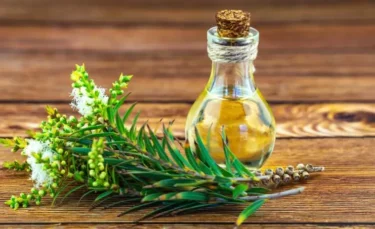
Tea tree oil is an essential oil that is known to be effective against acne, thereby helping promote clear skin. It also helps in faster wound healing9. To use tea tree oil, you first need to dilute it with some carrier oil, for example, olive, coconut or almond oil and apply it to the skin. Also, avoid using tea tree oil if you are allergic to it. You can do an allergy test by first applying it to a small area.
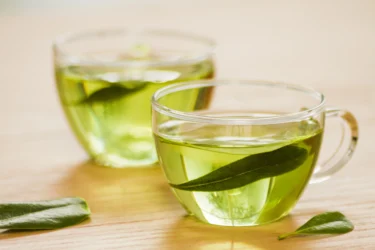
The extracts of green tea are helpful in the management of acne, thus helping in achieving clear skin. According to studies10, skin lotions containing green tea extracts proved to be efficient in the management of acne. You can make a green tea face mask using honey, green tea and baking soda. Mix these ingredients to make a paste. You can apply this paste as a face mask to get clear skin.
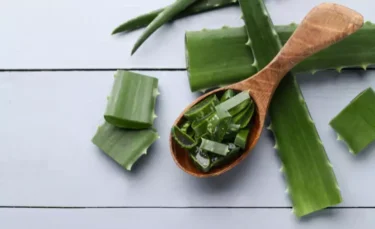
This herb can be used to manage acne, resulting in clear skin. Moreover, it helps soothe skin and clean up outbreaks. Aloe vera also helps to deal with inflammatory conditions like boils and cysts11. You can apply aloe vera gel directly on your face by massaging gently. Aloe vera gel can be added to your homemade face masks and face packs as well.
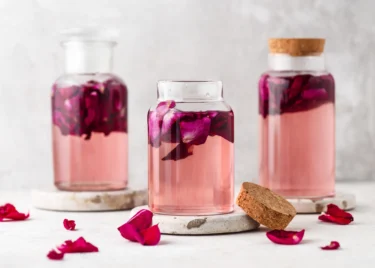
Rosewater is helpful in the management of acne and blackheads, thereby helping to attain clear skin12. To use rosewater, take some in your palms and massage gently on the face. You can also use cotton to gently dab the rose water on the skin.
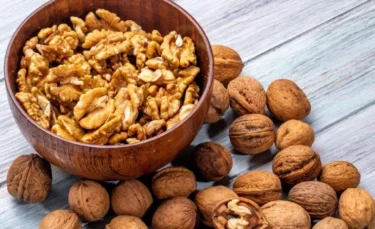
This herb is used to produce a great wash for a variety of skin issues, including worst cases of acne, thereby helping improve skin health and helping to obtain clear skin. To make walnuts a part of your skincare routine, you can use a walnut face mask and face scrubs. To make the walnut face mask, mix honey, besan (gram flour) and ground walnuts together to make a smooth paste. Apply this paste to the face as a face mask. To make walnut scrub, ground some walnuts and add some olive oil. Apply this scrub by gently massaging it on your skin.
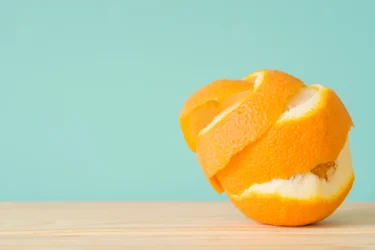
The juice and milk paste obtained from the orange peel is known to be effective in the management of acne. Therefore, it helps in promoting clear skin13. You can use orange peel powder to make face packs. Mix orange peel powder and yoghurt to make a paste. You can apply this orange peel and yoghurt face pack for clear and healthy skin.
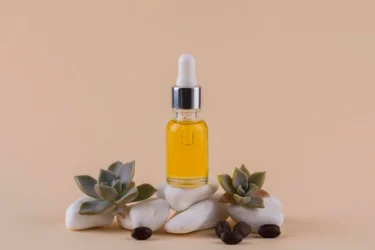
This essential oil has been used for dealing with acne and psoriasis, thereby resulting in clear skin14. Jojoba oil can be applied directly to the skin as a serum. But before using the oil, make sure you are not allergic to it by doing a patch test first. You can also put jojoba oil in other face packs to get clear and healthy skin.
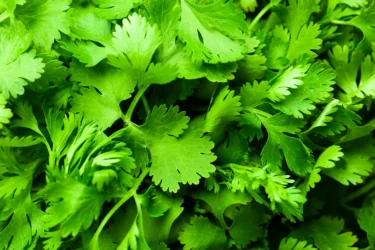
The oil of coriander has antibacterial and antifungal properties. Thus, it is helpful in managing acne, which in turn helps promote healthy and clear skin15. You can use freshly ground coriander leaves by mixing them with aloe vera gel. Apply it evenly on the face and massage gently for clearer skin.
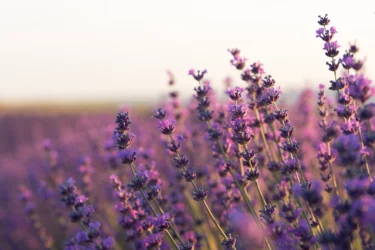
The extracts obtained from lavender have been used to deal with acne and help obtain clear skin16. Lavender oil can be applied to the skin after mixing it with carrier oils like olive or coconut oil. Gently massage this mixture on the face to get clear skin. You can also use a cotton ball to gently dab it on the skin.
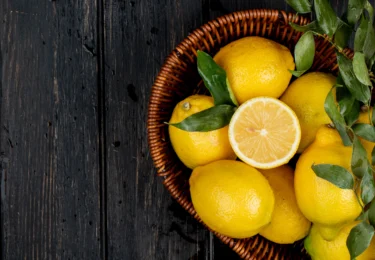
This fruit has been used for various skin conditions like acne, warts, sunburns, and scars17. To use lemon juice, mix a small quantity with honey and apply it to the face. You can also put lemon juice in your face pack recipes. If you feel any irritation after using lemon juice, wash it immediately.
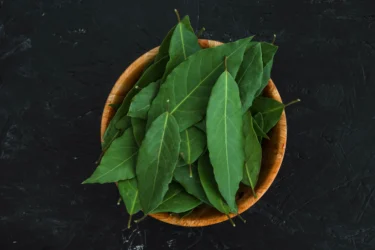
A few neem leaves can be taken and crushed to get a paste. This paste can be applied on the face where there is acne to get clear skin18. Making a neem face pack is easy. Start by boiling some neem leaves and orange peels. When they become soft, take them out. Grind them to make a smooth paste. Apply this paste to get clear skin.
At times, a poor diet that includes carbohydrates and sugars can lead to inflammation (swelling), redness, puffiness, and breakouts. To obtain glowing, clear skin, you can change to a diet that includes vegetables, fruits, seeds, nuts, and fish. A diet comprising tomatoes, spinach, salmon, and avocados contains various minerals and vitamins that help boost your skin health.
Pro Tip: A consistent skin care routine is the key to healthy, glowing skin. You may explore the benefits of products like topical Niacinamide serum, mild cleansers and moisturisers that suit your skin. Consume a balanced diet, stay hydrated and don’t mess up with your sleep schedule.
Also Read: 20 Foods To Eat For A Healthy Skin!
It is essential to visit a dermatologist (skin and hair specialist) when:
Also Read: Wonderful Home Remedies for Skin Tightening
Having clear, flawless skin is a dream for everyone. Conditions like acne, folliculitis, sun allergy, melasma, heat rashes and sunburns can result in marks on the face. Several home remedies like green tea, tea tree oil, rose water, lemon, lavender, jojoba oil, coriander, walnut, orange peel and aloe vera can be used to manage acne and other skin conditions and obtain clear, flawless skin. However, it is important to visit a doctor if your condition doesn’t improve or if you are anxious and want clear, flawless skin.
Walnut husks can be boiled with sufficient water, strained and then stored in a corked jug. It can then be used on the face to manage acne and obtain clear skin.
Orange peels can be taken and dried. The dried peels can be powdered and sieved. This powder can be combined with milk to obtain a paste. This paste can be applied to the face before going to bed at night. The peels of an orange or lemon can be put in a blender, and this juice can be used on the face to manage acne and obtain clear skin.
Rose petals can be dried and added to boiling water. This mixture is allowed to cool down and then can be consumed as a drink. It can also be used as a face wash or wet pack.
Poplar buds are used to manage acne, resulting in clear skin.
Disclaimer: The information provided here is for educational/awareness purposes only and is not intended to be a substitute for medical treatment by a healthcare professional and should not be relied upon to diagnose or treat any medical condition. The reader should consult a registered medical practitioner to determine the appropriateness of the information and before consuming any medication. PharmEasy does not provide any guarantee or warranty (express or implied) regarding the accuracy, adequacy, completeness, legality, reliability or usefulness of the information; and disclaims any liability arising thereof.
As we grow older, all the organs of the body begin to age and start showing signs of aging. This includes our skin too, which is the largest organ of our body. Though all parts of our body age, it is the aging of the skin that gains maximum attention because it is clearly visible. We always seek out different ways to delay this visible skin again[1].
Aging skin, especially on the face, affects self-image and has many social and emotional implications[2]. The signs of aging skin are clearly visible, like wrinkling, sagging, and a blotchy, uneven skin tone[3].
There are many reasons why skin becomes saggy as we age. These reasons may be internal (Intrinsic aging) or external (Extrinsic aging)[2].
Intrinsic aging develops over the years as time passes. The speed at which intrinsic aging occurs can vary from one individual to another. Let’s see what exactly happens in intrinsic aging[2].
Extrinsic aging happens due to the external factors as follows[3]:
Several natural home remedies that can help firm up loose skin are as follows:
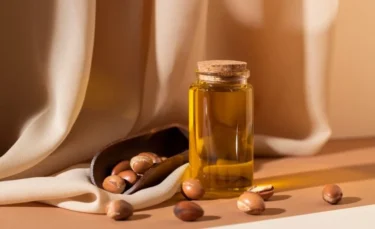
Traditionally, Argan oil has been used in hair and skin care products. It helps improve skin hydration and elasticity, thus giving the skin a young and supple look[7].
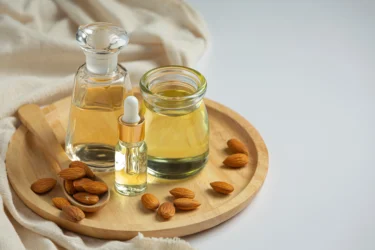
Almond oil softens the skin and helps improve skin tone and complexion. It also helps prevent skin damage caused by UV radiation, which is one of the most important causes of extrinsic aging.
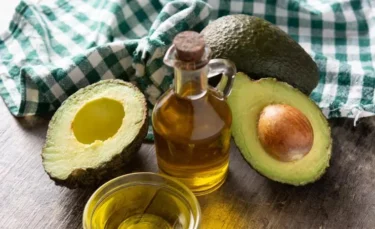
Avocado oil is known to increase the production of collagen, the main component that helps maintain the tightness of skin, thus preventing sagging and loose skin[9].
In addition to oils, there are certain natural ingredients that may offer mild skin-firming effects, though results can vary and are usually temporary.
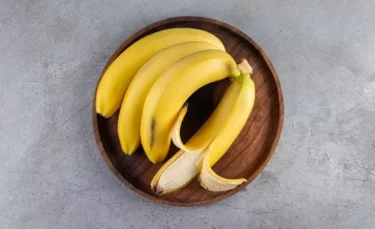
Bananas are rich in potassium, vitamins, and natural oils. They may help reduce the appearance of wrinkles, preventing a saggy look.
How to use it?
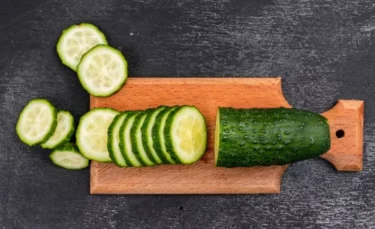
Cucumber helps retain elastin and hyaluronic acid, which are necessary to maintain firm skin[8].
How to use it?
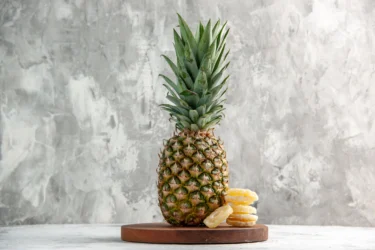
Pineapple contains a range of ingredients, including an enzyme that not only helps improve skin elasticity but also removes dead and damaged skin cells. It also enhances skin hydration, contributing towards giving a clear look to the skin[10].
How to use it?

The gel found in an aloe vera leaf tightens the skin by improving its elasticity. It also stimulates collagen and hyaluronic acid production, thus preventing wrinkles[11].
How to use it?
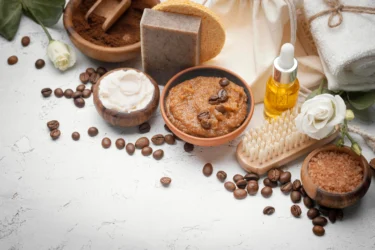
Coffee contains caffeine, which helps protect the skin from aging due to oxidative stress[12].
How to use it?
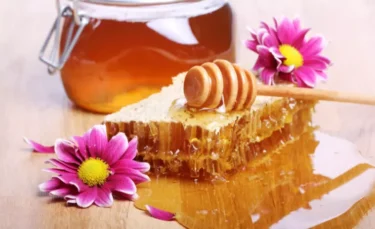
Honey helps in the detoxification of the skin. It also helps improve skin elasticity and smooths out wrinkles[13].
How to use it?
Also Read: Best Home Remedies For Smelly Armpits
Also Read: White Patches On Skin: Causes, Symptoms And Home Remedies
With these tips and simple home remedies, there’s no need to rely on artificial or expensive cosmetics to manage saggy skin. Just take a look in your kitchen, and you’ll find fresh, natural ways to keep your skin smooth and supple!
Also Read: Beauty Benefits of Using Ice Cubes On The Skin
While surgery for sagging skin (‘surgical lift ‘) can give the most radical results, one might not be the ideal candidate for it. For example, skin tightening procedures are not recommended for expecting mothers, people on certain medications and if someone has skin infection. Consult a skin specialist to know if you can go for surgery for sagging skin.
There are no scientific studies available which show that the effect of skin tightening by home remedies is permanent. However, since there are no side effects, if you see results, you can continue them regularly.
Yes, you may opt for commercially available skin-tightening lotions and creams or for non-invasive skin-firming procedures like laser treatment, ultrasound or radiofrequency after consulting a skin specialist.
Yes, to be cautious about not breaking out into an allergy due to any of the remedies mentioned here, you may ask your doctor to conduct a skin patch test for you. The skin patch test is a simple, non-invasive test that can detect allergic reactions to any substance1[16].
Disclaimer: The information provided here is for educational/awareness purposes only and is not intended to be a substitute for medical treatment by a healthcare professional and should not be relied upon to diagnose or treat any medical condition. The reader should consult a registered medical practitioner to determine the appropriateness of the information and before consuming any medication. PharmEasy does not provide any guarantee or warranty (express or implied) regarding the accuracy, adequacy, completeness, legality, reliability or usefulness of the information; and disclaims any liability arising thereof.
Gel-like collections of blood that form in our veins or arteries are known as blood clots. The blood changes its form, going from liquid to partially solid, jelly-like. Clotting is a normal body function that helps the body from excessive blood loss when we suffer from injuries or wounds. Nevertheless, when these blood clots are formed in places where they do not get dissolved, or on their own, they can cause serious threats to your health1.
A blood clot is usually initiated as a response to a wound on a blood vessel. An unwanted blood clot is called a thrombus. When a blood clot is stationary it is called thrombosis, while when this blood clot moves through the body, it is identified as a dangerous condition called thromboembolism or embolism. Blood clots can form both in the arteries (arterial clots) or the veins (venous clots).
Knowledge of your condition and the risk factors involved may help you identify and prevent this potentially life-threatening condition.
Did you know?
There can be several reasons for blood clot formation. You may also get a blood clot if you2:
Symptoms of blood clots may depend on its location in your body. Some people may experience no symptoms at all.
Read along further for a few home remedies for blood clot treatment for you to try at home. You must always consult your doctorbefore trying any of these on your own. Please note these might give momentary relief and not treat your clot permanently.
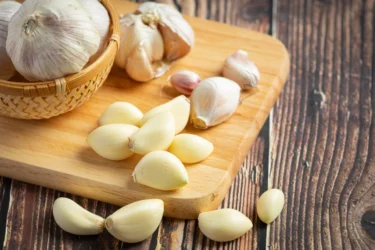
Garlic is known as an effective anti-coagulant food as it might prevent clotting of blood3. Garlic might help in blood thinning and reduces blood clot formation in the arteries. It further might help to prevent atherosclerosis. You may eat a few raw garlic cloves on an empty stomach in the morning.
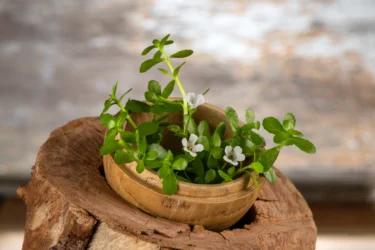
Brahmi has been traditionally used since long in both traditional Ayurvedic and Chinese medicine. It may help prevent formation of blood clots4. Bramhi can be consumed in the form of herbal juice, tea and powder at bed time for benefits.
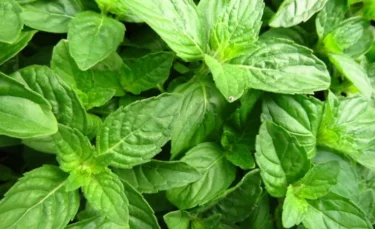
Tulsi has been used since ancient times to cure vascular diseases (disease that affects your circulatory system ) & other conditions. Tulsi extract has shown moderate to good activity in studies5 for breaking down clots. Since the preliminary studies make this claim, you must consult your doctor before using tulsi to manage blood clots. You can chew fresh tulsi leaves or drink tulsi tea for its benefits. You can prepare tulsi tea by boiling fresh or dried tulsi leaves in some water and straining the leaves.
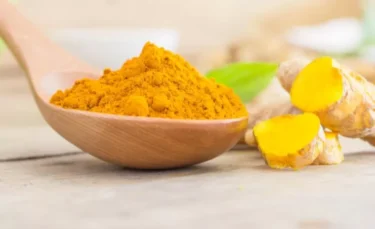
Turmeric extract has shown its benefits in dissolving blood clots in some studies5. Further studies are required to confirm this property of turmeric, therefore one must consult their doctor before using it to manage blood clots at home. You can add turmeric to food items like curries and soups or add it to hot water to make tea. You may also have turmeric by adding it to a glass of warm milk and consuming it immediately.
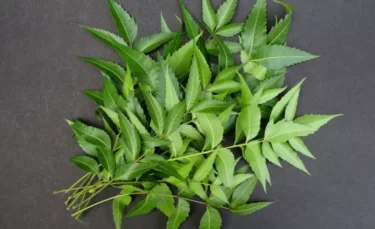
Neem extract was studied5 and found effective as it demonstrated good or moderate clot-breaking activity. To experience the benefits of neem, you can consume neem leaf extract or neem tablets.
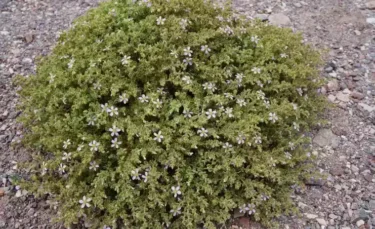
Dhamasa has been studied6 in vitro to possess thrombolytic properties that may dissolve blood clots. The best way to have fagonia or dhamasa powder is to mix it with heated desi ghee and consume it immediately.
You can prevent blood clots by following the simple measures given below:
Do not neglect any symptoms associated with blood clots, as they can pose a life-threatening risk. Increased clotting time, elevated platelet levels, fluctuating blood pressure and abnormal coagulation profiles serve as indicators that aid in recognizing the potential for clotting. Seek immediate medical attention for accurate diagnosis and effective management of such conditions.
Dr. Arpit Verma, MBBS, MD (Pharmacology)
In case you suspect a blood clot, you should call your doctor right away. You should seek immediate medical attention if any blood clots form in your veins (venous clots) or arteries (arterial clots) as it can be very dangerous.
Also Read: Natural Blood Thinners: Benefits, Risks, and Precautions
Generally, a blood clot forms in response to an injury on a blood vessel. The formation of an unwanted blood clot needs to be attended immediately as it may be a serious condition. Symptoms of a blood clot depends on the place where the clot is formed while in some people the clot may not exhibit any symptoms. Natural remedies for blood clots can help you get relief from the condition and knowledge of the risks behind the condition will help you make the right decisions. You can also help yourself by keeping active and following your doctor’s suggestions and making necessary lifestyle changes.
Also Read: The Best Home Remedies For Hernia
Yes, blood clots are a life-threatening medical condition. In the condition where blood clots move in the body, also known as embolism, the blood clots formed in the legs, arms, and groin can move to other parts of your body such as lungs leading to pulmonary embolism2. If you suspect a blood clot, rush to the doctor or visit the emergency room right away.
Several home remedies like neem, bramhi, turmeric, garlic, tulsi etc. may help you get some relief from blood clots and may even dissolve the clots4,5, but you should always consult your doctor in case you feel you may have a blood clot as it is a very serious condition and can put your life in danger.
Yes, several lifestyle changes and preventive measures such as wearing compression socks, staying active, raising your legs 6 inches above the level of your heart from time to time, consuming low salt diet, and following the doctor’s advice can help you prevent blood clots2.
Yes, some factors are based on lifestyle choices that make you at higher risks of getting clots, such as smoking cigarettes.
Disclaimer: The information provided here is for educational/awareness purposes only and is not intended to be a substitute for medical treatment by a healthcare professional and should not be relied upon to diagnose or treat any medical condition. The reader should consult a registered medical practitioner to determine the appropriateness of the information and before consuming any medication. PharmEasy does not provide any guarantee or warranty (express or implied) regarding the accuracy, adequacy, completeness, legality, reliability or usefulness of the information; and disclaims any liability arising thereof.
Kidney stones can be extremely painful and impact your daily life if not addressed in time. These tiny, hard deposits can form anywhere in your urinary system, such as kidneys, ureters, bladder, or even the urethra. When your urine is overloaded with certain minerals or salts, like oxalate, uric acid, or struvite, they can crystallize and clump together, eventually forming stones.
Contact your doctor immediately if you notice any common signs of kidney stones like pain, dark or bloody urine, fever, and nausea. Your doctor will recommend the best measures to take care of your kidney stones, such as medications, surgery (usually minimally invasive), some non-invasive procedures (shockwave lithotripsy, ureteroscopy), and certain dietary changes. As you read on, you’ll find some of the top dietary recommendations that you may get from your doctor.
Friendly Reminder: The information shared here is for educational purposes only and the reader should consult a registered medical practitioner before implementing any changes to their health routine.
Studying the stone type can help your doctor understand why you have it and how to reduce the risk of having it in future. Given below are the four types of kidney stones:
Oxalates are produced in the body as well as absorbed from the food we eat. Calcium can bind to oxalate and form calcium-oxalate stones, this is one of the most common types of kidney stones. Certain factors may encourage calcium-oxalate stone formation, such as low intake of water, excessive amounts of oxalate in the body and urine, and high salt levels in your diet[3]. To combat this, you need to:
Uric acid is a waste product that is made when your body breaks down purines. Purines are found in nearly all plants and meats but some foods have higher concentrations. These include red meats[4], organ meats, seafood and alcohol. Purines get broken down into uric acid and this uric acid ends up in the kidneys or other parts of the urinary tract in the process of elimination from the body. When there is too much uric acid in the urine, crystals can form, leading to uric acid kidney stones. Here are some dietary recommendations for people with uric acid stones[2]
Struvite stones are caused due to infection. Good hydration and intake of citrus juices like orange and cranberry juice are said to be helpful for these cases[2].
People with or at risk of cystine stones are advised to increase their fluid intake, mainly through water[2].
When the type of stone is not known, you may consider the following points helpful:

It is very important to stay hydrated when you have kidney stones. Your doctor may recommend a fixed amount of water that you need to drink daily, try to stick to this recommendation[5].
In my experience, I have found that ensuring an adequate intake of fluids, especially water, is crucial in avoiding kidney stones. Drinking enough liquid helps to dilute urine and reduce the concentration of substances that can form stones. By staying well-hydrated, you can promote healthy kidney function and decrease the risk of kidney stone formation.[2]
Dr. Siddharth Gupta, B.A.M.S, M.D (Ayu)

Lemons are a great source of citrate which is believed to make urine less acidic. Uric acid stones can form and grow when urine is acidic hence lemons and limes are great for dissolving these stones if they form. Lemon juice should be diluted with water and can be taken[7].
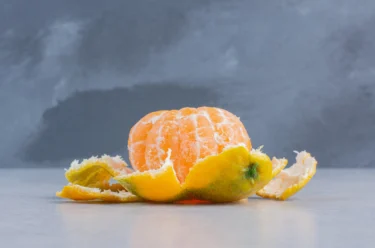
Oranges, like lemons and limes, are citrus fruits with citrate present in them. This has the same benefits as lemon juice and also lowers the acidic level of urine. High acidity in urine is linked with some common types of kidney stones.
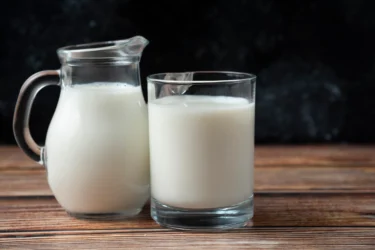
Milk is a great source of dietary calcium. While taking calcium through supplements is linked to higher rates of kidney stones, consuming it from food sources like milk is linked to a lower risk of calcium oxalate stones[11].
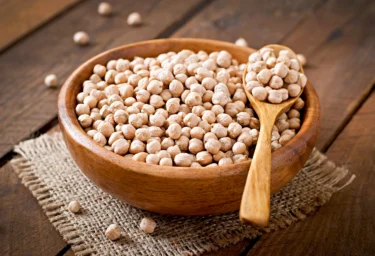
Everyone needs protein to stay healthy and these three vegetarian sources are good for those with kidney stones. Non-vegetarian protein foods can increase your risk of kidney stones, so try to increase your intake of lentils, peas, and beans instead. People with high uric acid levels may need to reduce protein intake.
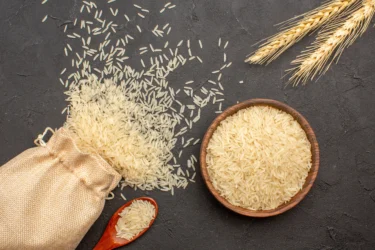
Cooked white rice and oats are also low in oxalates. If you want to lower your risk of developing kidney stones, you can either cut down your oxalate levels or increase your calcium levels to bind the oxalate. Rice and oats can be part of a low-oxalate diet.
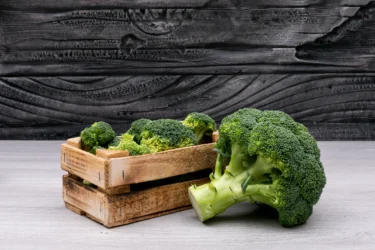
Broccoli contains low levels of oxalates, which is not only good for a lower risk of calcium oxalate stones, but also a great source of potassium. Potassium is important because it binds to calcium which decreases the chance of a stone forming. Potassium may also be involved in dissolving calcium oxalate and calcium phosphate kidney stones[8].
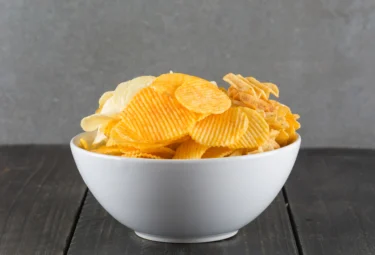
High sodium levels are linked to a higher risk of kidney stones and more calcium being passed through the urine. This increases the risk of stones developing so you should avoid salty foods since these can increase your sodium levels. Processed, prepackaged, fast foods and canned foods are high in salt. Always check the sodium content on the food label before you eat pre-made foods[9].
Based on my experience, I always advise my patients to inquire about the sodium content of the food when dining out. It’s important to be mindful of your sodium intake as excessive sodium consumption can contribute to high blood pressure and other health issues. By asking about the sodium content, you can make more informed choices and opt for lower-sodium options to support your overall health.
Dr. Smita Barode, B.A.M.S, M.S.
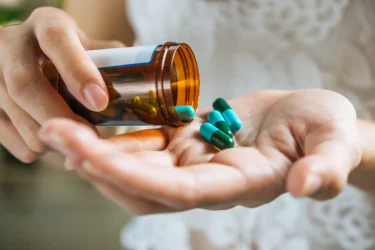
Vitamin C can get converted into oxalate in the body if it is taken in excessive amounts, such as a supplement[12]. Avoid using vitamin C supplements unless prescribed by a doctor and try to get your daily intake of this nutrient from natural sources only.
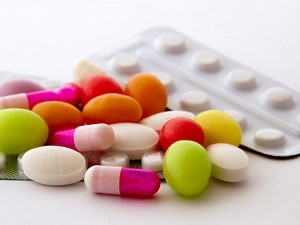
Taking calcium through food sources does not increase the amount of calcium in your urine. However, excessive intake of calcium supplements provides your body with much more calcium than you need. This leads to more calcium being passed out of the body through the urine, which can increase the chances of a stone forming[13]. If you need to maintain your calcium levels, talk to your doctor and find out what dietary options can be opted for instead of calcium supplementation.
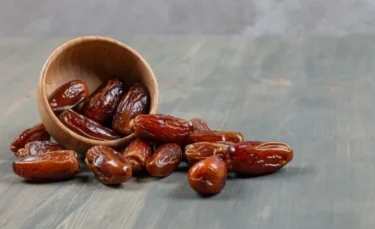
Fruits like rhubarb, dates, and raspberries may worsen your kidney stones since they are high in oxalate content[14]. Try to eat fruits like bananas, apples, and cherries instead
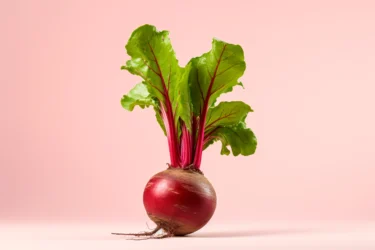
Veggies like spinach, potatoes, beetroots, and carrots are also high in oxalates[14]. Since these are healthy foods, you should not avoid them entirely. Instead, you can eat calcium-rich foods during the same meal to balance out your oxalate levels.
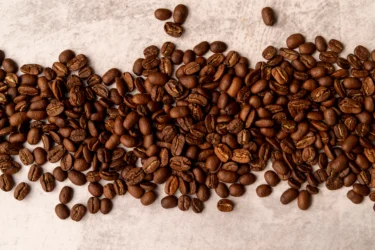
Caffeine can cause your body to pass more urine, which may lead to dehydration. Low levels of water in the body increase the risk of kidney stones. You should speak with your doctor and ask them if you can still drink coffee when you have kidney stones.
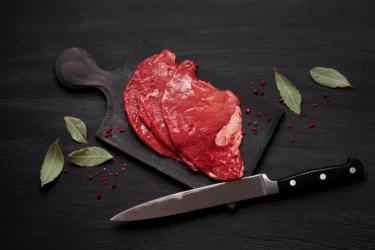
Eating too much protein from animal sources can lead to uric acid building up in your body. Apart from calcium oxalate, uric acid is another substance that can form kidney stones. If you only get your protein from non-vegetarian foods, you may risk a higher chance of uric acid kidney stones. Try to avoid animal-based proteins and use vegetarian sources instead.
Did you know that men are more prone to developing kidney stones compared to women? If you have a family history of kidney stones, your risk of developing them further increases. Additionally, once you’ve had kidney stones in the past, you are more likely to experience them again.
Dr. Rajeev Singh, BAMS
Here are a few recipes to try in case you currently have kidney stones. These recipes include low oxalate ingredients to curb the growth of stones as well as ingredients that may dissolve existing stones. Speak with your doctor before trying out any new diet plan.
Kidney stones can be managed with timely medical care, so it’s important to consult your doctor as soon as you suspect their presence. If left untreated, these stones can grow larger and cause more complications. A balanced diet can play a significant role in prevention and management. In some cases, surgical removal might be necessary. To tailor your diet and treatment plan, consult your doctor and refer to the list above for foods to include and avoid.
No, calcium is an important nutrient and is required for a healthy body. You do not need to avoid calcium-rich foods unless your doctor specifically tells you to do so. In most cases, they will recommend avoiding calcium supplements instead.
Fruits high in citrates, such as lemons and oranges are great for kidney stones.
Milk contains calcium which will bind with the oxalates in your digestive system and lowers the risk of calcium-oxalate forming in the urinary tract. Too much calcium-oxalate in your kidneys and urine can result in kidney stones forming.
1. National Kidney Foundation. Kidney Stones. Available from: https://www.kidney.org/kidney-topics/kidney-stones
2. National Institute of Diabetes and Digestive and Kidney Diseases. Eating, Diet, & Nutrition for Kidney Stones. Available from: https://www.niddk.nih.gov/health-information/urologic-diseases/kidney-stones/eating-diet-nutrition
3. National Kidney Foundation. Six Easy Ways to Prevent Kidney Stones [Internet]. New York: NKF; [cited 2025 Feb 25]. https://www.kidney.org/kidney-topics/six-easy-ways-to-prevent-kidney-stones
4. National Kidney Foundation. Kidney Stone Diet Plan and Prevention [Internet]. New York: NKF; [cited 2025 Feb 25]. https://www.kidney.org/kidney-topics/kidney-stone-diet-plan-and-prevention.
5. Gul Z, Monga M. Medical and dietary therapy for kidney stone prevention. Korean J Urol. 2014 Dec;55(12):775-9. [cited 2025 Feb 25].https://pmc.ncbi.nlm.nih.gov/articles/PMC4265710/
6. MedlinePlus. Kidney stones – self-care. Accessed 2025 Feb 25. https://medlineplus.gov/ency/patientinstructions/000135.htm.
7. Ruggenenti P, Caruso MR, Cortinovis M, et al. Fresh lemon juice for recurrent calcium oxalate stones: A PROBE trial. EClinicalMedicine. 2021 Dec 14;43:101227. [cited 2025 Feb 25]. https://pmc.ncbi.nlm.nih.gov/articles/PMC8683665/
8. National Kidney Foundation. Broccoli. Accessed February 25, 2025. https://www.kidney.org/kidney-topics/broccoli.
9. Sakhaee K, Harvey JA, Padalino PK, Whitson P, Pak CY. Salt abuse and kidney stone risk. J Urol. 1993 Aug;150(2 Pt 1):310-2. [cited 2025 Feb 25]. https://pubmed.ncbi.nlm.nih.gov/8326549/
10. Eating, Diet, & Nutrition for Kidney Stones https://www.niddk.nih.gov/health-information/urologic-diseases/kidney-stones/eating-diet-nutrition
11. Calcium Oxalate Stones https://www.kidney.org/kidney-topics/calcium-oxalate-stones
12. Effect of vitamin C supplements on urinary oxalate and pH in calcium stone-forming patients https://www.sciencedirect.com/science/article/pii/S0085253815489768
13. Calcium intake and urinary stone disease https://pmc.ncbi.nlm.nih.gov/articles/PMC4708574/
14. Oxalate Content of Foods.xls https://ucikidneystonecenter.com/wp-content/uploads/2020/06/Oxalate-Content-of-Foods.pdf
Disclaimer: The information provided here is for educational/awareness purposes only and is not intended to be a substitute for medical treatment by a healthcare professional and should not be relied upon to diagnose or treat any medical condition. The reader should consult a registered medical practitioner to determine the appropriateness of the information and before consuming any medication. PharmEasy does not provide any guarantee or warranty (express or implied) regarding the accuracy, adequacy, completeness, legality, reliability or usefulness of the information; and disclaims any liability arising thereof.
Swollen gums might feel abnormally bulging and protruding. It is a common problem where one or many triangle-shaped areas of gum between teeth swell. Gum diseases, also called periodontal diseases, affect the gums supporting the teeth. Swelling in the gums can be a symptom of underlying gum diseases, like gingivitis1.
If you have swollen gums, you should get help from a dentist to get a diagnosis and treatment. You can also try home remedies to take care of the swelling at home. Read on to find some herbs and remedies to help take care of swollen gums at home.
The most common cause of swollen gums is bacterial plaque, a thin layer of bacteria. Plaque results in various conditions of the gums, like gingivitis and periodontitis. These conditions can give you red and swollen gums3.
Swollen gums can also be a result of1:
Swollen gums can be a symptom of an underlying health condition like gingivitis. Features of swollen gums include:
Periodontitis is the progressive stage of gingivitis, which occurs if gingivitis is left untreated. Periodontitis is characterised by symptoms like2:
Here are some natural remedies that you can use to take care of your swollen gums at home. You should try the one that works best for you. These remedies involve some commonly found herbs that you can easily find in your house.

Turmeric has anti-inflammatory activity, which might help in reducing gum swelling. Turmeric is also a good pain-relieving agent, which might aid in pain relief. You can use haldi or turmeric to take care of your gums. Make a paste using turmeric, salt, and some mustard oil. You can apply this paste to teeth and gums to get rid of dental problems5. However, if you feel any irritation after using it, you should immediately rinse it off.
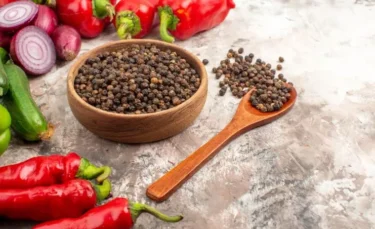
You can grind some black pepper to make powder and use this powder with mustard oil to make a paste. This paste can be used to massage the teeth and gums to steer clear of dental problems like swollen gums5.
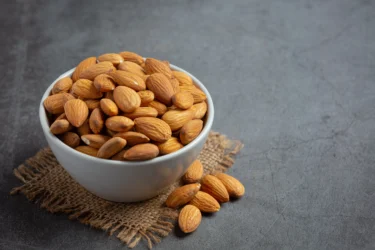
Almonds can be used as a remedy for gum problems. You can use the shell powder of almonds to take care of gum diseases. To make the powder, you can burn the shells of almonds, powder them and use them as and when required as a tooth powder5.
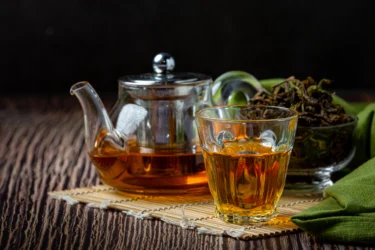
The antibacterial properties of green tea might help get rid of swollen gums4. You can try adding a few cups of green tea to your diet to help with swollen gums. However, avoid using this remedy if you are allergic to caffeine.
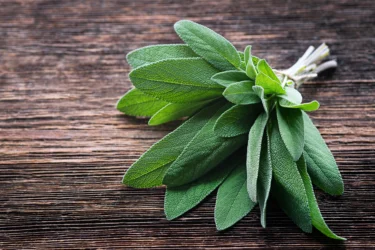
Sage is known to have antioxidant benefits, which might help soothe swollen gums8. You can use sage to make a mouthwash of your own by putting some fresh sage leaves into boiling water. Boil the leaves for some time before straining them. You can store this solution and use it as a mouth rinse. If you don’t find fresh leaves, you can use dried leaves as well.
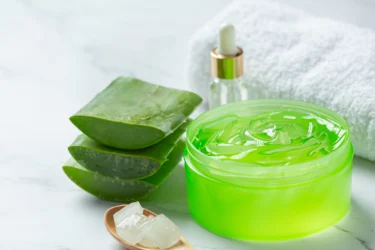
The inflammation-reducing benefits of aloe vera make it an excellent natural remedy for swollen gums8. You can directly use pure aloe vera juice as a mouth rinse. You can also massage aloe vera gel onto the gums. Make sure to buy the aloe vera juice from a good source. Also, check if you have any allergic reaction to aloe vera; in such cases, avoid using it.
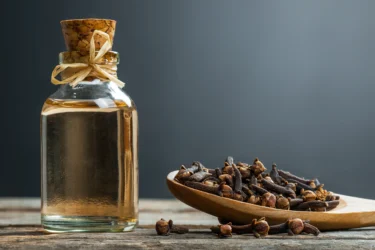
Clove oil helps prevent the growth and formation of bacteria, thereby preventing infections. Clove is also a good pain reliever and might help with pain associated with swollen gums8.To use clove for gums, mince some cloves, and use a cotton swab or cotton ball to apply the powder to your gums. Let the powder sit on the gums for some time. Rinse the clove off your gums once done.
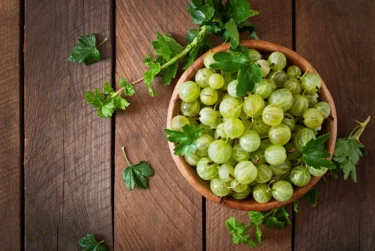
Amla fruits contain vitamin C in ample amounts. Vitamin C is a potent antioxidant beneficial in many health conditions. You can include one fresh amla fruit in your everyday diet to help with swollen gums. You can also use amla powder by mixing it with some water. You can drink this water to take care of your swollen gums.
If you are suffering from allergies to the remedies mentioned above, you should avoid using them. Instead, choose a remedy that works best for you.

Here are some simple tips that can help you manage gum problems:
Swollen gums are a common problem that some people may ignore. However, if the changes in your gums, the redness and swelling last for more than two weeks, you need to seek medical help.
Also, visit your dentist if your gum problems are associated with:
Also Read: Best Home Remedies for Burning Feet
Swelling in the gums is a common problem and can occur at any age. Most people often neglect gum problems, as sometimes there is no pain involved. However, timely management is necessary to prevent the problem from worsening. Some common household ingredients like turmeric, black pepper, clove, and amla can be used to take care of swollen gums at home. You can also make herbal mouthwashes at home using dried or fresh leaves of sage. Make sure to take into consideration any allergies before using such home remedies. Also, if the swelling in the gums becomes painful and is accompanied by bleeding when you eat or drink, make sure to get a consultation from a dentist.
Also Read: Simple Home Remedies For Dry Throat
Natural home remedies that you can make use of to take care of swollen gums are black pepper powder, turmeric powder, clove, and amla. You can also use aloe vera, sage leaves, and green tea to relieve swelling in the gums.
Yes, swollen gums can also bleed. This bleeding might become more evident when you eat or brush your teeth3. You can contact a dentist to get a better diagnosis of your problem.
Gum problems can be prevented by maintaining good oral hygiene. Practices like brushing the teeth two times a day, using a good toothpaste, and using dental floss might help prevent gum problems from developing7.
Yes, swollen gums can signify health conditions like gingivitis, but you need to consult with a doctor or dentist to get a proper diagnosis.
If your swollen gums do not heal within two weeks and cause bleeding and pain, you should immediately contact a dentist.
Yes, you can use turmeric for swollen gums. You can use turmeric powder and apply it to your gums to get rid of swollen gums. Turmeric is known to reduce inflammation and swelling as it has anti-inflammatory benefits. However, if you are allergic to turmeric, you should avoid its use. Also, if turmeric use does not work out and the swelling persists, seek medical help.
The antioxidant properties in sage leaves are helpful in many health problems. You can make a herbal mouthwash using sage leaves. Drop some fresh or dried sage leaves in boiling water, and let them simmer for some time. Cool it and store it. Use this mouthwash to take care of swollen gums.
Yes, salt water can help swollen gums. Rinsing the mouth with warm salt water (saline solution) can reduce inflammation and soothe gum tissues. The saltwater rinse can also help to cleanse the area and promote healing. However, it’s essential to maintain regular dental care and consult a dentist if the swelling persists or worsens.
Yes, certain foods high in sugars or acids can contribute to gum irritation and inflammation. Smoking or using tobacco products can also lead to gum problems. Adopting a balanced diet and avoiding harmful habits can promote good gum health.
Yes, certain vitamin deficiencies, particularly vitamin C deficiency, can lead to gum problems, including swollen gums. Vitamin C plays a crucial role in maintaining gum health, and inadequate intake can weaken gum tissues. A balanced diet rich in vitamins and minerals is essential for gum health.
1. Gums – swollen: MedlinePlus Medical Encyclopedia [Internet]. [cited 2022 May 6]. Available from: https://medlineplus.gov/ency/article/003066.htm
2. Healthdirect Australia. Gingivitis. Symptoms, Treatments, Complications and Prevention | Healthdirect. [cited 2025 May 19]. Available from: https://www.healthdirect.gov.au/gingivitis
3. Gum disease – Better Health Channel [Internet]. [cited 2022 May 6]. Available from: https://www.betterhealth.vic.gov.au/health/conditionsandtreatments/gum-disease
4. Agarwal G, Chatterjee A, Saluja M, Alam M. Green tea: A boon for periodontal and general health. Journal of Indian Society of Periodontology. 2012 [cited 2025 May 19]. Available from: https://pmc.ncbi.nlm.nih.gov/articles/PMC3459493/
5. Ayush Division. Ayurveda offers Herbal healing. Available from: https://www.esic.nic.in/attachments/publicationfile/7d11b02e5abb4717d53b4ce05efabd21.pdf
6. Gum disease – NHS [Internet]. [cited 2022 May 6]. Available from: https://www.nhs.uk/conditions/gum-disease/
7. Gingivitis: MedlinePlus Medical Encyclopedia [Internet]. [cited 2022 May 6]. Available from: https://medlineplus.gov/ency/article/001056.htm
8. Rani N, Singla RK, Narwal S, Tanushree N, Kumar N, Rahman MdM. Medicinal plants used as an alternative to treat gingivitis and periodontitis. Evidence-based Complementary and Alternative Medicine. 2022 [cited 2025 May 19]. Available from: https://pmc.ncbi.nlm.nih.gov/articles/PMC10630018/
Disclaimer: The information provided here is for educational/awareness purposes only and is not intended to be a substitute for medical treatment by a healthcare professional and should not be relied upon to diagnose or treat any medical condition. The reader should consult a registered medical practitioner to determine the appropriateness of the information and before consuming any medication. PharmEasy does not provide any guarantee or warranty (express or implied) regarding the accuracy, adequacy, completeness, legality, reliability or usefulness of the information; and disclaims any liability arising thereof.
Next Page »« Previous Page